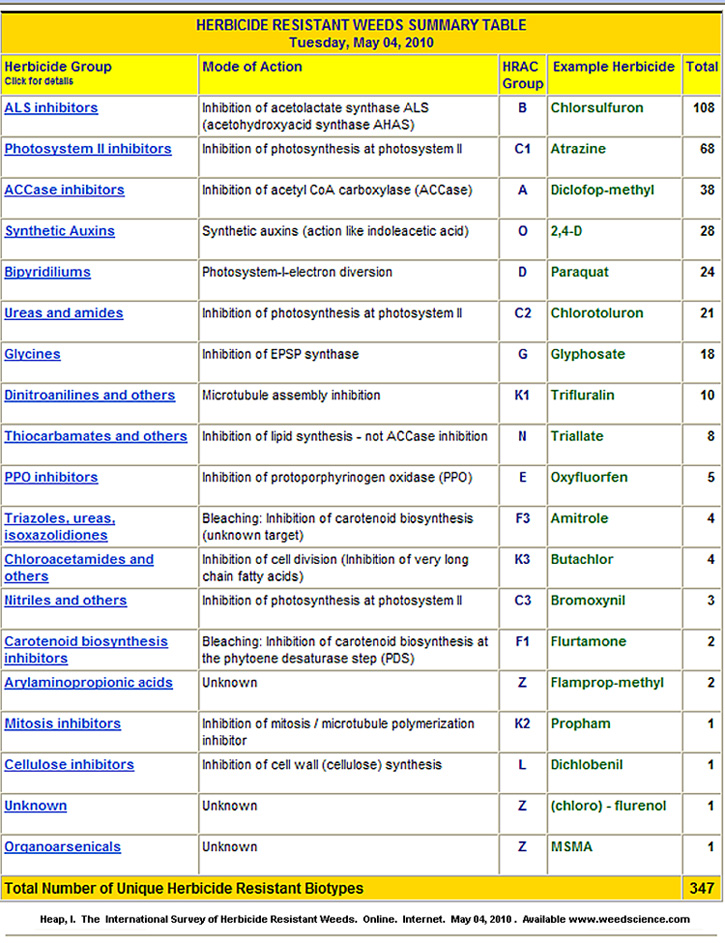Competency Area 2: Weed Management
PO 21. Chemical – Be familiar with problems associated with herbicide use-
A. Herbicide resistant weeds – Know weeds that have developed herbicide resistant populations in the NE and practices involved in herbicide resistance management;
B. Be familiar with problems of off-site movement of herbicides;
C. causes of herbicide injury;
D. Understand the advantages and disadvantages of herbicide persistence as it relates to weed control, crop rotation and water quality.
E. Pesticides are potential sources of non-point pollution of surface and groundwater.
A. Herbicide resistance - has been defined by WSSA as “the inherited ability of a species to survive and reproduce following exposure to a dose of herbicide normally lethal to the wild type. In a plant, resistance may be naturally occurring or induced by such techniques as genetic engineering or selection of variants produced by tissue culture or mutagenesis“.
Related definitions include:
Cross resistance is resistance to other herbicides within a similar chemical group such as to atrazine and to other triazines.
Multiple resistance is the evolution of populations resistant to herbicides not chemically related and having different sites of action.
Factors that increase the potential for herbicide resistant weed populations include: |
 click to enlarge |
B. Be familiar with problems of off-site movement of herbicides
Spray drift is the physical movement of spray particles to non-target areas. Vapor drift is caused by the volatilization of herbicides from plant and soil surfaces with subsequent vapor movement and injury of non-target species.
C. Causes of herbicide crop injury
Excessive application rates
Improper application methods
Synergistic mixtures or sequential applications
Susceptible hybrids/varieties
Abnormal soil/climatic conditions
D. Understand the advantages and disadvantages of herbicide persistence as it relates to weed control, crop rotation, and water quality.
Carryover affecting rotational crops depends on:
Herbicide decomposition
o Microbial
o Chemical
o Photodecomposition
o Plant metabolism
Availability for breakdown altered by
o Volatilization
o Plant uptake
o Adsorption on soil colloids
o Leaching or movement of water through a soil profile may move herbicides
Avoid herbicide carryover
o Read and follow label
o Use minimum dose
o Calibration and application
o Rotate herbicides
o Use short residual herbicides
o Integrate with other control measures
E. Pesticides are potential sources of non-point pollution of surface and groundwater.

Pesticide data base provides pesticide surface runoff and leaching potential based on:
-The half-life of a pesticide is the number of days for concentration to decrease by one-half.
-The soil sorption index (Koc) is a measure of the tendency to be attached to soil particles.
Soil sorption depends on pesticide chemistry, organic matter content of the soil and the clay
content of the soil.
-Water solubility is the parts-per-million (ppm) that will dissolve in water at room temperature
-The soils data base ranks soils according to their potential for pesticide loss through
leaching or surface runoff.

-Soil-pesticide interactions determine leaching and/or surface loss potentials.
o Potential 1 - has a high probability of being lost to leaching or runoff.
o Potential 2 - has the possibility of being lost to leaching or runoff.
o Potential 3 - has a low probability of being lost to leaching or runoff.
Quick Links
- Competency Area 1: Integrated Pest Management (IPM)
- Competency Area 2: Weed Management
- Competency Area 3: Management of Infectious Plant Diseases
- Competency Area 4: Management of Arthropods
- Competency Area 5: Pesticide Formulations and Labels
- Competency Area 6: Management of Pesticide Resistance
- Competency Area 7: Using Pesticides in an Enviromentally Sound Manner
- Competency Area 8: Protecting Humans from Pesticide Exposure
